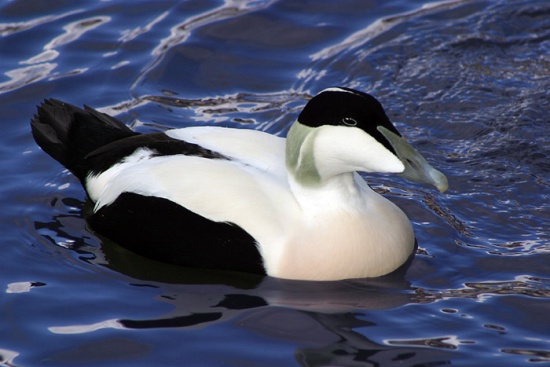- Somateria mollissima
Identification
Male - black and white, green nape, large wedge-shaped bill. Female - brown.

Photo by: Gary Clark
Location: Gaspé Peninsula, Quebec, Canada.
Distribution
The commonest and most widespread of the eiders, breeding across much of the north and extending further south than any other. Breeds around virtually the whole of Iceland, in the Faroes and around the north of Ireland, most of Scotland and parts of northern England. In Continental Europe breeds in Brittany, the Netherlands, Denmark, Germany and Poland. Has recently bred in Switzerland and northern Italy. Around Scandinavia found on most coasts including the Baltic coasts but absent from the Gulf of Bothnia, and in the Baltic States. To the north breeds on Svalbard, Franz Josef Land and Novaya Zemlya and on the coast of Arctic Russia around the Kola Peninsula and White Sea. There is a small but increasing population far from the main breeding range in the Ukraine. Has bred in Poland and Austria.
Northernmost populations move south in winter but most populations are dispersive rather than migratory and movements are of no great distance.
Range more extensive in winter, found around coasts of southern Britain and northern France and scarce on lakes in Central Europe and in the northern Mediterranean. Vagrant south to the Azores, North Africa and the western Black Sea.
Taxonomy
Six subspecies are recognized[1]:
Over most of the Western Palearctic, breeding birds belong to the nominate race.
Those of the Faroes, Shetland and Orkney are faroeensis, smaller, with greyer bill and shorter frontal lobes in male and darker, more heavily barred plumage in female.
The most northerly breeders in the region, from Iceland, and Greenland to eastern Canada belong to the race borealis with bright orange-yellow bill in male and more rufous plumage in female. Recorded as a vagrant in northern British Isles.
Race v-nigra is found in eastern Siberia and western North America
dresseri from eastern Canada and USA has been reported as a vagrant from Scotland
sedentaria is found in central Canada (Hudson Bay).
Habitat
Shallow inshore seas breeding on small islands or undisturbed mainland beaches, on passage and in winter also on estuaries, rarely on inland waters.
Behaviour
Breeding is often colonial with colonies on small islands. Arrival of Fox (in Europe: Vulpes vulpes) can lead to decimation or eradication of such breeding colonies[2]. The nest is built close to the sea and is lined with eiderdown, plucked from the female's breast.
The diet includes crustaceans, molluscs, and mussels.
Vocalisation
<flashmp3>Somateria mollissima (song).mp3</flashmp3>
Listen in an external program
References
- Clements, James F. 2007. The Clements Checklist of Birds of the World. 6th ed., with updates to October 2007. Ithaca: Cornell University Press. ISBN 9780801445019
- Paper in DOFT read December 2008




